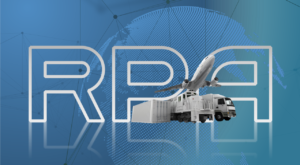The COVID-19 pandemic has many enterprises exploring ways technology can help them keep their operations going, even when employees can’t be at work. One of the technologies receiving a lot of attention is robotic process automation (RPA). Bernard Marr (@BernardMarr) explains, “Robotic process automation is technology designed to automate business processes that are rules-based, structured, and repetitive, thereby freeing up people to focus on more value-adding business activities. RPA is part of a wider shift towards automation, amidst a ‘perfect storm’ of technology that encompasses AI, machine learning, big data, robotics, and the Internet of Things.”[1] Some pundits have called RPA a gateway to artificial intelligence. Marr adds, “This move towards greater automation will impact every industry. In fact, analysts at Gartner have predicted that 85% of large organizations will have deployed some form of RPA by 2022, and it’s only a matter of time before RPA is routinely deployed in smaller and mid-sized firms, too. So if you haven’t yet considered the potential impact of RPA on your business, now is a good time to do so.”
What is robotic process automation?
The term “robotic process automation” can be a bit confusing because of the word “robotic.” Business journalist Andrew Martins (@Andrew_Martins) explains, “Though its name might evoke images of an uprising of metal and lasers, robotic process automation is anything but that. At its core, RPA is a piece of ‘robot’ software that lets users reduce the number of repetitive tasks they need to do on a computer by mimicking those actions. From timecard management to data entry, RPA tools eliminate the need for employees to spend their time on computer-based, routine tasks. Instead, employees can focus their energies where they’re actively needed, increasing overall productivity.”[2] Journalist Zach Cooper adds, “Robotic Process Automation encompasses software tools that partially or fully automate human activities; usually those which are manual, rule-based and monotonously repetitive. This variant of automation must not be confused with AI, which differs as it can learn and grow without human input.”[3]
Karl Fischer, Chief Marketing Officer & Head of AI & Data Analytics at DVT, defines RPA in more layman-like terms. He writes, “[RPA] is not artificial intelligence or physical robots doing work that a person could be doing. To put it simply, RPA is a bit of software that acts in the capacity of a person. Think of any business process where someone might be sitting behind a PC capturing information, manual administrative tasks that are repetitive. … That is where RPA comes in.”[4] He adds, “The benefits for organizations would be to reduce manual workload, increase the speed of capturing information and reduce capturing errors by automating processes. Bots don’t get tired, they don’t get sick and they certainly don’t drink the last of the coffee.”
Getting started with RPA
Marr notes, “RPA shouldn’t really be thought of as new processes; RPA is all about complementing or improving existing systems and applications.” To get started with RPA implementation, Marr recommends following five simple steps. They are:
Step 1. Educate yourself. Marr explains, “Education is a vital part of preparing for change. Luckily, there are some fantastic RPA-related resources online that you can use to get up-to-speed.” Education should include learning more about RPA and also learning more about your processes. Bill Gates (@BillGates) once noted, “The first rule of any technology used in a business is that automation applied to an efficient operation will magnify the efficiency. The second is that automation applied to an inefficient operation will magnify the inefficiency.”
Step 2. Understand what types of processes can and can’t be automated. “Typically,” Marr writes, “the most suitable tasks for RPA relate to ‘busy work’ — meaning any work that involves a great number of repetitive actions, such as opening and searching records, transferring data between different digital locations, and repetitive mouse clicks. These sorts of tasks are prime candidates for automation. At the other end of the scale, jobs that involve creative thought and human decision making generally are not suitable for automation.”
Step 3. Narrow down to which tasks should be automated. Marr explains, “Just because something can be automated, doesn’t mean it should be. Here, you’ll need to identify which — of all the things it’s possible to automate — are your key priorities. I recommend focusing on those tasks that help your organization achieve its overall aims, but currently consume a disproportionate amount of employees’ time.”
Step 4. Research available solutions and tools. “Having decided on the best ways to deploy RPA in your organization,” Marr writes, “you can begin researching the technologies that are available and the potential partners you may need to work with to create a successful deployment.”
Step 5. Pick your RPA partner. Marr recommends asking a simple question, “Of all the solutions available, which one best suits your needs?”
Fischer adds, “RPA is not a solution for everything despite what seems to be the perception at the moment. RPA is just that piece of software that is going to act in an administrative process to enable faster, more accurate capture and potentially reduce risk in terms of business processes as well.”
Beyond RPA
As Marr observed above, RPA is great for tasks that are rules-based, structured, and repetitive. Occasionally, however, enterprises need more advanced technologies. Technology writer Priya Dialani (@priyadialani248) explains it this way, “RPA is without decision-making ability. Artificial Intelligence and its intrinsic disciplines, including Machine Learning (ML), Natural Language Processing (NLP), and so forth, help to acquire the learning and decision-making abilities in an RPA task. Basically, RPA is for doing. Artificial intelligence is for contemplating ‘what should be done’. Artificial intelligence makes RPA intelligent. Together, these advances offer ascent to Cognitive Automation, which automates many use cases, which were just inconceivable before.”[5] At Enterra Solutions®, we call AI-enhanced RPA Cognitive Process Automation™ (CPA). Cognitive Process Automation goes beyond the accomplishment of routine tasks. CPA has the potential not only to automate, but to improve processes by dynamically processing and executing subtle decisions as if they were made by the best human expert. To be clear, not all programmable processes require advanced cognitive technologies. Simple, rule-based processes get along fine with RPA.
Scientist and journalists Astha Oriel (@Pencoffee1) writes, “One of the most valuable and critical steps in the process of RPA is cognitive automation. Unlike RPA, which requires a pre-requisite set of rules, cognitive automation performs tasks that require critical thinking and human intelligence. Cognitive automation is one of the automation processes and is often known as intelligent automation.”[6] She adds, “Cognitive automation can be defined as the process that utilizes artificial intelligence technologies to perform tasks such as sifting through the data, segregating unstructured data, and handling complex, unstructured and data-laden tasks for performing tasks with efficiency accuracy. This technology is designed to imitate human intelligence.”
Concluding thoughts
Cooper concludes, “For all the genius in the simplicity of its processes, [RPA] can only deal with a restricted range of tasks. As it isn’t self-learning, it needs rules to follow, and therefore, as rules and systems are updated, RPA has a shelf-life. To this, it must be said that deploying RPA is merely the first step towards change. Automating a process solves only the problem at hand, rather than the fundamental method. Using RPA alongside other digitization tools can form better processes which have a lasting effect.” Fischer adds, “As with any technology investment, you have to be sure you are going to drive out the ROI expected. When you consider that your bot may be able to run 24 hours a day, never off sick, never asking for leave and doing exactly what you ask it to, it might seem an easy-to-achieve outcome. It will not happen that way unless you plan the journey for RPA in your organization and have a clear backlog of process where you can fully realize the opportunity for automation: take the ‘machine’ out of people’s daily work and have them do the hard stuff, the human stuff.”
Footnotes
[1] Bernard Marr, “Robotic Process Automation Is Coming: Here Are 5 Ways To Prepare For It,” Forbes, 9 October 2020.
[2] Andrew Martins, “What Is Robotic Process Automation?” Business.com, 7 October 2020.
[3] Zach Cooper, “What is Robotic Process Automation?” ITPro, 9 October 2019.
[4] Karl Fischer, “What is Robotic Process Automation?” ITWeb, 5 July 2019.
[5] Priya Dialani, “How Robotic Process Automation Can Become More Intelligent,” Analytics Insight, 15 October 2020.
[6] Astha Oriel, “Unveiling the Power of Cognitive Automation,” Analytics Insight, 20 September 2020.





